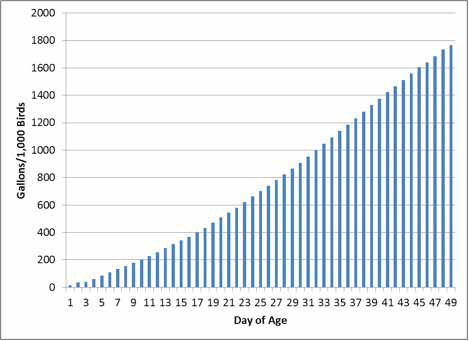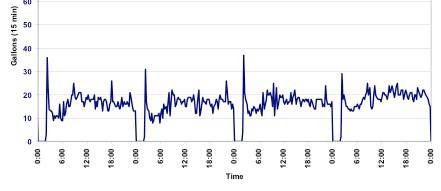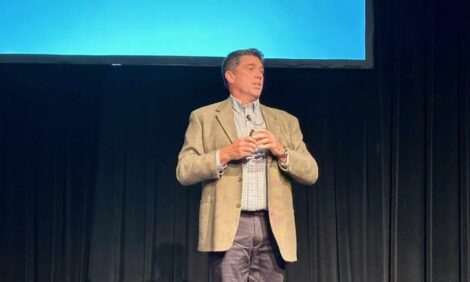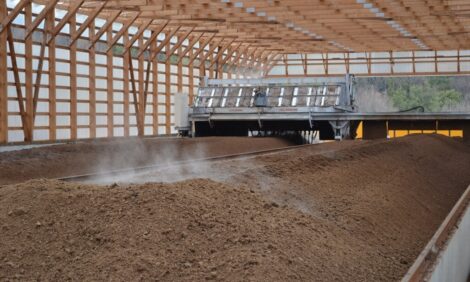



Poultry Drinking Water Primer
The importance of water, factors affecting water consumption, water quality and management tips are reviewed by Brian D. Fairchild and Casey W. Ritz, Extension Poultry Scientists at the University of Georgia.Water is a critical nutrient that receives little attention until a problem arises. Not only should producers make an effort to provide water in adequate quantity, they should also know what is in the water that will be flowing through the water lines to be used in evaporative cooling systems and consumed by the birds.
Water Functions
Water is needed for bird consumption, reducing air temperature (including evaporative cooling pad and fogging systems) and facility sanitation. Broilers consume approximately 1.6 to 2.0 times as much water as feed on a weight basis. Water is a critical nutrient in bird metabolism and nutrition. From a physiology perspective, water consumed by the bird is used for nutrient transportation, enzymatic and chemical reactions in the body, body temperature regulation and lubrication of joints and organs.
There is a strong relationship between feed and water consumption, therefore, water can be used to monitor flock performance. Many of the electronic controllers in poultry houses have the ability to monitor daily water consumption and have inputs for multiple water meters. This would allow a water meter to be installed separately on the lines supplying water to the front and rear of the house. Bird uniformity between the front and back of the house can be monitored using water consumption. Water consumption will be greater in the area of the house that has more birds. When birds are not distributed evenly between the front and back of the house it increases the competition for feed and water space. This, combined with the extra heat from excessive numbers of birds, can reduce bird performance.

Factors Affecting Water Consumption
There are several factors that affect water consumption:
Bird age: Water consumption increases with age but decreases as a percentage of body weight.
Environmental temperature/heat stress: Birds consume more water as temperature increases. One of the main
ways birds regulate body temperature is by evaporating water through the respiratory system during panting. As
birds pant, water is lost and needs to be replaced in order to maintain body-water balance. Water consumption
can double and even triple during periods of heat stress. Water consumption in broilers increases approximately
seven per cent for each degree Fahrenheit increase in temperature.
A study at the University of Georgia examined the relationship of feed consumption to water consumption of seven consecutive flocks on a commercial broiler farm. As temperatures increased, the water consumed per pound of feed consumed also increased (Table 1).
| Table 1. Water consumption response to different weather conditions | |
| Lb of water per pound of feed | |
|---|---|
| Cold weather | 1.55 |
| Mild weather | 1.65 |
| Hot weather | 1.75 |
Water temperature: Several studies have examined the effects of providing cool water to birds during hot
weather. In most of these studies, water temperature has improved the performance of broilers and layers. Any water temperature below the body temperature of the bird will be beneficial. The water consumed will help dissipate body heat and aid the bird in body temperature regulation. However, it is very difficult to cool the water significantly when moving the water hundreds of feet down a house.
Electrolytes: During periods of potential heat stress, many producers supplement drinking water with electrolytes.
Electrolytes are minerals that can be found in the blood and are important for normal cell function and growth. Electrolytes, as the name implies, help regulate nerve and muscle function by conducting electrical signals from nerves to muscles.
Electrolytes are also important for the acid-base balance of the blood and fluid retention. Some of the electrolytes found in blood plasma include sodium (Na), potassium (K), calcium (Ca), magnesium (Mg), chlorine (Cl), bicarbonate (HCO3) and sulphate (SO4). The addition of the electrolytes not only replenishes those depleted during heat stress, but also stimulates water consumption. When the results of these are added together (electrolyte intake and increased water consumption), the mortality due to heat stress can be reduced.
Lighting programmes: Light is another environmental factor that can influence bird water consumption. Birds will
not drink if they are not eating and vice versa. During dark periods, the birds rest and as a result, they do not consume water. The exception is long dark periods. In dark periods exceeding eight hours, it is not unusual to see some water consumption register on the water meter. In operations that utilise lighting programmes, two distinct water consumption peaks can be observed. The first peak is just after the lights come on (dawn) and the second is just prior to lights turning off (dusk).
The correlation of water consumption with feed intake and many environmental factors indicate its importance in bird metabolism and body function. Efforts should be made in all poultry operations to ensure that adequate and unlimited access to water is provided. Failure to do so will result in reduced feed intake, poor egg production, reduced growth and reduced feed efficiency.

Water Quality
While water is composed of hydrogen and oxygen molecules (H2O), it is a universal solvent and as a result can
contain many minerals and compounds. The only sure way to get pure water is to use distillation or other treatment
methods to remove dissolved minerals and compounds. This can be expensive considering the volume of
water a typical broiler farm consisting of four or more houses would consume. Water treatment should be done
based on the results of water quality analysis. While poultry drinking water does not have to be pure, heavily
contaminated water is undesirable.
Water composition varies with geographical region as the nature of the geological makeup changes. Water contamination
can occur if surface water drains into the well. All farms should submit water samples to a qualified
laboratory for testing to establish a baseline for water quality. This will help producers determine if and what
water treatment might be warranted.
Water quality should be of concern to all poultry operations. Poor water quality may interfere with digestion and
subsequent bird performance. The effectiveness of vaccines and medications administered through the water
lines could be reduced when water quality is poor. Water contaminants could create equipment problems that
would either restrict the amount of water available for consumption or the effectiveness of the evaporative cooling
and fogging systems. Reduced water consumption or cooling capacity may have detrimental effects on both
growth and reproduction. Poor water quality could also result in leaky water nipples inside the house, which will
wet litter and lead to increased ammonia production. Poor litter quality and high ammonia can result in reduced
performance and livability.
Standards for water quality should include factors that affect taste, solid buildup within water systems and toxicity.
Factors that should be observed for poultry production include, but are not limited to those listed in Tables 2 and 3.
| Table 2. Drinking water quality characteristics | |
| Colour | Water is colourless and any colour in the water may indicate an increased contamination level. |
| Turbidity | Particles such as clay, silt, sand or organic material in suspension can cause the water to appear cloudy or muddy. Turbid water can cause leaky nipples and clog fogging nozzles. |
| Hardness | Calcium and magnesium salts cause the water to be “hard” and can lead to scale and sludge build–up within water lines. Hardness reduces the effectiveness of soaps, disinfectants and the administration of some medications. |
| Iron (Fe) | Iron will stain almost everything it contacts, and it is a common water quality issue. Recent studies indicate that Fe in the water does not appear to affect poultry health. However, some of the Fe may form solid particulates such as iron oxide, which can lead to equipment problems. These small particles can lead to leaky nipples and block fogging nozzle openings. Either of these conditions can have negative impacts on poultry production. Iron bacteria are more likely to thrive in water with high Fe concentrations. As a result, biofilm build-up can occur, which can obstruct nipple drinkers and promote pathogen proliferation. |
| Manganese (Mn) | While Mn itself does not cause a negative effect on poultry health, like iron, it can form solid particulates that can result in leaky nipples and stop up foggers. |
| Nitrate (N) | Elevated N concentrations are indicative of decaying organic material and have been correlated with poor oxygen utilization in animals, but recent studies observed no differences in broiler performance with nitrate levels as high as 600ppm. Presence of nitrate is a good indicator that water should be checked for bacteria. |
| pH | The pH is a measure of acidity or alkalinity. A scale from 0 to 14 is used to measure pH. A value of 7.0 is neutral, values less than 7.0 are acidic and values greater than 7.0 are basic. A pH of 6.0 to 6.8 is preferred for broiler production; however, birds can tolerate a pH range of 4 to 8. A pH greater than 8 could result in reduced water consumption. |
| Alkalinity | Alkalinity is caused by calcium carbonate, bicarbonate or sulphate. High alkalinity increases the buffering capacity of water. |
| Total solids | Total solids represent the total amount of solid material in both suspension and solution. Total solids are not directly linked to any poultry health issues. However, equipment function and water delivery could be negatively affected by the presence of total solids, which could influence bird performance. |
| Toxic compounds | The amount will vary depending on the compound; however, elements such as lead, selenium and arsenic should be kept below 1.0ppm to prevent bird health problems and residues. |
| Dissolved oxygen | Normal ground water concentrations have little or no dissolved oxygen. Concentrations greater than zero are indicative of possible surface water influence. |
| Bacteria | Bacteria levels should be kept to a minimum (see Table 3.) |
Many of the water quality standards for poultry drinking water were originally developed from those for human
drinking water. Few of the standards recommended today are based on research utilizing broiler or layers.
Recently, a series of studies has been conducted examining the effects of iron (Fe), manganese (Mn), nitrates (NO3)
and pH levels in drinking water on poultry performance. The results of these studies have found that very high
levels of Fe, Mn and NO3 do not impact broiler health. In those studies no differences in performance were noted
due to 600ppm of Fe, 600ppm of NO3 and 20ppm of Mn.
It should be noted that the water lines were thoroughly flushed between studies and that particulates that result from high Fe and Mn levels can lead to equipment problems such as leaky nipples and clogged fogging nozzles. Broiler performance is more likely to be affected by improper equipment function rather than bird health due to high concentrations of these substances. Poor water quality can lead to increased microbial growth (such as iron bacteria) and biofilm build-up.
| Table 3. The following table may be used as a guide for drinking water quality for poultry | |
| Contaminant, Characteristic or Mineral | Maximum Acceptable Levels |
|---|---|
| Bacteria Total Heterotrophic Bacteria Coliform Bacteria |
100 CFU/100 ml 50 CFU/100 ml |
| pH | 6.0 – 8.0 |
| Hardness | 110ppm |
| Naturally Occurring Compounds Calcium Chloride Copper Iron* Magnesium Manganese** Nitrate*** Phosphorus Potassium Sodium Sulphate |
500 ppm 250 ppm 0.6 ppm 0.03 ppm 125 ppm 0.05 ppm 25 ppm 0.1 ppm 500 ppm 50 ppm 250 ppm |
| * Iron as high as 600ppm has been shown to not affect bird health but will have detrimental effects on water lines and fogging systems (Fairchild et al., 2005). ** Manganese as high as 20ppm has been reported to not affect bird health, but can have negative effects on water lines and fogging systems (Batal et al., 2005). *** Nitrates as high as 600ppm have been shown to not affect bird health (unpublished data). |
|
Water Management Tips
Conduct water tests
Each farm should have its well water tested. Water quality can change during periods of heavy rain or drought and additional water tests during these periods will ensure that water lines continue to deliver adequate water volume for both the birds and the cooling systems. County agents can provide more information on the tests available, provide information on fees for testing and submit samples to the Agricultural and Environmental Services Laboratory at the University of Georgia.
Change filters regularly
Sediment and other particulates can cause leaky water nipples that can have negative effects on litter quality. Clogged filters restrict water flow to the drinker and cooling systems. In some cases, simple cartridge filters may not be adequate, such as for water with high iron. In those cases, other water treatments will need to be considered.
Flush water lines regularly
A high–pressure flush should be performed on water lines between each flock and after adding supplements through the medicator, e.g. vaccines, medications, vitamins, electrolytes, etc.
Plan ahead before treating water
Before implementing water treatment or sanitation programmes, consult your county agent to ensure that contaminants in your water will not react negatively and cause the water system to become clogged.
References
Batal, A.B., B.D. Fairchild, C.W. Ritz and P.F. Vendrell, 2005. The effect of water manganese on broiler growth performance. Poultry Sci. 84 (Suppl. 1.).
Bell, D.B., 2002. Consumption and quality of water. In: Commercial Chicken Meat and Egg Production. D.D. Bell and W.D. Weaver, eds. Kluwer Academic Publishers, Norwell, MA. p411-430.
Carter, T.A. and R.E. Sneed, 1987. Drinking water quality for poultry. PS&T Guide No. 42, Extension Poultry Science, North Carolina State University, Raleigh, NC.
Dozier, D.A., M. Czarick, M.P. Lacy, and B.D. Fairchild, 2002. Monitoring water consumption on commercial broiler farms: Evaluation tool to assess flock performance. Poultry Sci. 80:154 (Suppl. 1.).
Fairchild, B.D., A.B. Batal, C.W. Ritz and P.F. Vendrell, 2006. Effect of drinking water iron concentration on broiler performance. J. Appl. Poultry Res. 15:511-517.
May, J.D., B.D. Lott and J.D. Simmons, 1997. Water consumption by broilers in high cyclic temperatures: Bell versus nipple waterers. Poultry Sci. 76:944-947.
Pesti, G.M., S.V. Amato and L.R. Minear, 1985. Water consumption of broiler chickens under commercial conditions. Poultry Sci. 64:803-808.
Schwartz, D.L. Water Quality. VSE, 81c., Penn. State Univ. (mimeographed)
Waggoner, R., R. Good and R. Good, 1984. Water Quality and Poultry Performance. Proceedings AVMA Annual Conference, July.
May 2012








